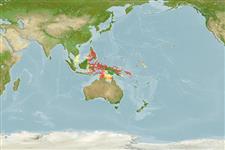Classification / Names
Common names | Synonyms | Catalog of Fishes (gen., sp.) | ITIS | CoL | WoRMS | Cloffa
Actinopterygii (ray-finned fishes) >
Perciformes (Perch-likes) >
Gobiidae (Gobies) > Gobiinae
Etymology: Trimma: Greek, trimma, -atos = something crushed (Ref. 45335); haimassum: Name from the Greek word 'haimasso' meaning stained with blood, referring to the blood-red spot above the posterior end of the opercle in live and fresh specimens.. More on author: Winterbottom.
Environment / Climate / Range
Ecology
Marine; demersal; depth range 7 - 70 m (Ref. 87358). Tropical, preferred ?
Western Pacific: from Indonesia (SW Sulawesi) north to the Philippines (Palawan) and eastwards to the Solomon Is., probably also in Palau.
Size / Weight / Age
Maturity: Lm ? range ? - ? cm
Max length : 3.1 cm SL male/unsexed; (Ref. 87358)
Short description
Morphology | Morphometrics
Dorsal
spines
(total): 7;
Dorsal
soft rays
(total): 10;
Anal
spines: 1;
Anal
soft rays: 8 - 10. This species is characterized by having the following characters: a relatively deep body, numerous irregular scales with about 30 lateral rows and over 15 scales in the anterior transverse series, a fifth pelvic fin ray that branches twice dichotomously, usually a somewhat elongate second dorsal spine, no predorsal, cheek or opercular scales, a moderately wide bony interorbital with a fleshy median ridge between the eyes, and a dermal ridge anterior to the first dorsal spine. There is a red spot or elongate blotch above the opercle in live and fresh material, and the dorsal surface of the snout has a reticulated dark pattern, with dark transverse stripes over the dorsal margin of the orbit (Ref. 87358).
Inhabits caves and ledges on steep outer reef slopes (Ref. 90102).
Life cycle and mating behavior
Maturity | Reproduction | Spawning | Eggs | Fecundity | Larvae
Winterbottom, R., 2011. Six new species of the genus Trimma (Percomorpha; Gobiidae) from the Raja Ampat Islands, Indonesia, with notes on cephalic sensory papillae nomenclature. Aqua, International Journal of Ichthyology 17(3):127-162. (Ref. 87358)
IUCN Red List Status (Ref. 115185)
CITES (Ref. 94142)
Not Evaluated
Threat to humans
Harmless
Human uses
More information
Common namesSynonymsMetabolismPredatorsEcotoxicologyReproductionMaturitySpawningFecundityEggsEgg development
Age/SizeGrowthLength-weightLength-lengthLength-frequenciesMorphometricsMorphologyLarvaeLarval dynamicsRecruitmentAbundance
ReferencesAquacultureAquaculture profileStrainsGeneticsAllele frequenciesHeritabilityDiseasesProcessingMass conversion
Tools
Can't connect to MySQL database fbquizv2. Errorcode: Too many connections
